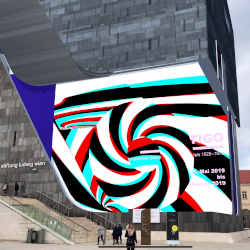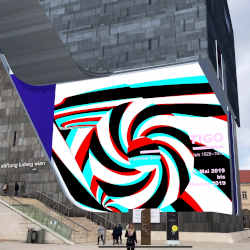
Augmented reality (AR) has been a small part of the art world for several years. Now, use of the technology is expanding as AR-ready smartphones containing a camera and sensors to position and orientate the device are increasingly available, art galleries and museums continue to vie for customers, and the technology becomes more familiar through use in other sectors. Add an emerging digital environment, a generation of smartphone users, and growing curiosity about the potential of technology in culture, and AR could become a pillar of 21st century art.
AR allows users of smartphones and other enabled devices (such as headsets, glasses, and tablets) to see images, objects and locations with a digital augmentation overlaid.
Technologies supporting AR include image recognition, which gives AR apps the ability to detect two-dimensional images and trigger digitally augmented content; object recognition, which enables real-time 360-degree AR experiences around physical objects, and location-based AR, which allows developers to add digital content to geographical points of interest (the basis of mobile game Pokémon GO).
The Franklin Institute in Philadelphia, PA, opened one of the first publicly acclaimed exhibitions using AR in 2017, showing 10 of the life-size clay warriors of the Terracotta Army found at the burial site of China's first emperor. Visitors to the exhibition could download an AR app to their smartphones and see representations of how the sculptures are believed to have appeared more than 2,000 years ago. They also could see digitally augmented artifacts and weapons held by the AR warriors.
The AR technology behind the Franklin Institute exhibition was developed by Wikitude, a Salzburg, Austria software-as-a-service company offering a software development kit (SDK) for AR apps. To date, about 140,000 developers are using Wikitude, with the art and museum sector among the fastest growing in terms of purchasing tools in 2019. Says Paula Perrichot, marketing lead at Wikitude, "There is great demand for AR apps in art galleries and museums, and a lot of education is going on right now about how to use the technology."
The Wikitude SDK has been used to create AR apps for a number of art galleries in Europe. For the Uffizi Gallery in Florence, Italy, for example, Rome-based ComPart Multimedia used the kit to create The unofficial guide to the Uffizi Gallery, an image recognition app that allows visitors to scan and instantly identify and learn about any of the 500-plus artworks on display.
Taking a different tack, Vienna, Austria-based Artefact Mixed Reality Studio used Wikitude object recognition and scene-tracking technology, which makes it possible to recognize, track and augment scenes and large objects, to transform the exterior image of Vienna's mumok museum of modern art, as seen by smartphone users with the Artefact app. The transformation turned the image of the museum into a gigantic urban stage showing museum-related content and information about exhibitions. The dual aims of the AR project were to attract new visitors to the museum, and to provide information for frequent visitors.
Also based in Vienna, Artivive offers a similar solution to Wikitude in the shape of an AR development platform (also named Artivive) and tools that have been used by about 50,000 artists to create over 60,000 artworks that are hung in art galleries, studios and homes around the world (including two recent additions in Uruguay). Explains Artivive CEO Codin Popescu, "We see AR as a new medium to create art. You can combine analog and digital in one medium to tell stories using an image. The coolest thing is that when you put the technology in the hands of creatives, you are always surprised by the results."
Popescu suggests AR solutions are getting easier to use and notes that they are being used by artists across the board to create artworks from tattoos and street art to murals, illustrations, fine art, and digital stories. Artivive's technology platform requires no technical knowledge and allows artists to create three artworks free of charge before they must subscribe to use the platform.
Artivive works not only with artists, but also with museums, galleries, festivals and designers to provide apps that offer an interesting experience for visitors and prolong the time they spend at a show or event. Use-cases have included creation of digital content for the exhibition Film Stills, which was held at the Albertina Museum in Vienna in early 2017. Artivive's AR app brought stills of actors to life and allowed viewers to enjoy film scenes featuring famous actors such as Marilyn Monroe, James Stewart, and Charlie Chaplin. The Monet to Picasso – The Batliner Collection exhibition at the Belvedere Museum in Vienna allows users to see selected pieces in additional dimensions.
Last year, Artivive was used by the Bavarian State opera house in Munich to bring its 2019/2020 program, posters, and postcards to life. The annual 100 Best Posters 18 – Germany Austria Switzerland exhibition shows the winning posters from a graphic design competition in the German-speaking world in 2019. Exhibitions of the winning posters are held in Germany, Austria, and Switzerland, with some selected pieces activated by AR.
Further away, the company has also worked with venues such as the Shanghai Himalayas Museum, which used Artivive technology to augment the first Italian Masters Exhibition in China in 2017. In the same year, the Ying Art Center in Shanghai presented AR Artworks made by Wang Chienyang for his Fantastic Color Bar exhibition.
At the Massachusetts Institute of Technology (MIT), the ongoing Borderline Project covers a 200-foot-long wall in the tunnels under the campus with murals. The project's augmented reality animations can be experienced using the Artivive app, and more murals and animations are being added every semester.
As well as growing numbers of creative technology solutions and users, the AR art world is expanding with the inclusion of curators that promote and sell AR artworks.
Acute Art, a resident at Somerset House in London, works with artists across virtual and augmented realities to produce digital artworks, make them accessible through its website, app, and exhibitions, and sell them to collectors. One of the company's latest partnerships is with Brian Donnelly, aka the artist and designer Kaws.
New York-based Artsy curates a database of over a million works of art from about 100,000 artists, and all are for sale. The price of augmented reality art ranges from a few hundred to many thousands of dollars.
What is next for AR in art? Says Artivive's Popescu, "The key to success is that people love storytelling and in the digital age want to experience more in terms of 'seeing' stories. AR will become a well-recognized art form of the 21st century."
Sarah Underwood is a technology writer based in Surrey, U.K.




Join the Discussion (0)
Become a Member or Sign In to Post a Comment